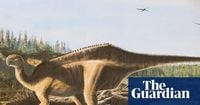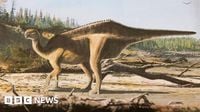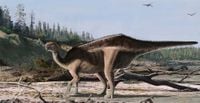On the windswept shores of the Isle of Wight, a remarkable discovery has thrust the island into the paleontological spotlight once again. Scientists have unveiled a new species of dinosaur, Istiorachis macarthurae, whose dramatic sail-like structure running along its back and tail is captivating both researchers and the public alike. This newly named relative of Iguanodon, described in detail on August 22, 2025, is rewriting what we know about dinosaur diversity in Early Cretaceous Britain—and it even honors a modern-day record-breaker from the same island.
The story begins with a set of 125-million-year-old fossils, originally excavated from the Isle of Wight’s south-west coast in the 1970s. For decades, these bones sat quietly in the collections of the Dinosaur Isle Museum, assumed to belong to one of the two known iguanodontian species from the area. But as fate would have it, a retired general practitioner with a passion for paleontology, Jeremy Lockwood, decided to take a closer look as part of his doctoral research at the University of Portsmouth and the Natural History Museum, London.
Lockwood’s medical background gave him a keen eye for anatomical details. “While the skeleton wasn’t as complete as some of the others that have been found, no one had really taken a close look at these bones before,” Lockwood told Natural History Museum. “It was thought to be just another specimen of one of the existing species, but this one had particularly long neural spines, which was very unusual.”
These neural spines, protruding dramatically from the dinosaur’s vertebrae, formed a pronounced sail along its back and tail. The feature immediately set this animal apart from its relatives and ignited a flurry of questions about its function. Was it a thermal regulator, a fat storage device, or something else entirely?
Lockwood and his team, including Professor Susannah Maidment of the Natural History Museum, leaned toward a different explanation. “Evolution sometimes seems to favor the extravagant over the practical,” Lockwood explained in Papers in Palaeontology. “While the exact purpose of such features has long been debated—with theories ranging from body heat regulation to fat storage—researchers believe that the most likely explanation in this case is visual signaling, possibly as part of a sexual display, and this is usually because of sexual selection.”
The concept isn’t as far-fetched as it sounds. Many modern animals, from peacocks to deer, use exaggerated features to attract mates or intimidate rivals. Lockwood suggested that Istiorachis’ sail could have functioned much like a peacock’s feathers—an eye-catching display to impress potential partners or ward off would-be challengers. “Sexual signaling is the most probable explanation. When a characteristic is exaggerated beyond its practical function in living animals, it is invariably due to the evolutionary pressure to attract a mate. Istiorachis’ sail seems to be another example of that,” Lockwood told Natural History Museum.
The dinosaur’s name itself is a nod to both its anatomy and local heritage. Istiorachis means “sail spine” in Ancient Greek, while the species name macarthurae honors Dame Ellen MacArthur, the celebrated Isle of Wight sailor who, in 2005, set the world record for the fastest solo non-stop voyage around the globe. “It is certainly not an everyday occurrence to be asked if a newly discovered dinosaur could be named after you!” Dame Ellen said, as quoted by BBC. “I was somewhat taken aback when this conversation began, but felt hugely privileged to be asked. The fact that the Istiorachis ‘sail’ could be likened to the sails I have spent so much of my life below was very touching.”
The fossilized remains of Istiorachis macarthurae, now on display at the Dinosaur Isle Museum in Sandown, paint a picture of a medium-sized herbivore—roughly the size of an American bison and weighing about a tonne—that once roamed the lush floodplains of what is now southern England. The bones were first discovered by local fossil hunter Nick Chase, who passed away in 2019, and only recently received the detailed attention they deserved.
Lockwood’s research has had a profound impact on our understanding of the Isle of Wight’s ancient ecosystem. “Over the past five years, Jeremy has single-handedly quadrupled the known diversity of the smaller iguanodontians on the Isle of Wight, and Istiorachis demonstrates we still have much to learn about Early Cretaceous ecosystems in the U.K.,” said Professor Maidment, as reported by Natural History Museum.
The rise of sail-backed dinosaurs like Istiorachis macarthurae marks a broader evolutionary trend. According to findings published in Papers in Palaeontology, elongation of neural spines among iguanodontians began in the Late Jurassic and became relatively common during the Early Cretaceous. However, the kind of hyper-elongation seen in Istiorachis—where the spines stretch to more than four times the height of the vertebral body—remains a rare adaptation.
But why did these sails evolve at all? The research team compared the fossilized backbones of Istiorachis with those of other dinosaurs and living animals. While some reptiles today, like the Philippine sailfin lizard, sport similar structures, such features are mostly the domain of extinct creatures like Spinosaurus and Dimetrodon. The team suspects that, in addition to sexual selection, the sail might have helped individuals recognize each other within herds or even deter predators by making the animal look larger. Still, the evidence most strongly supports the idea of visual signaling for mating purposes.
Despite the excitement, the story isn’t without setbacks. Some fossils of Istiorachis were stolen from a dig site over 50 years ago and have yet to be recovered, leaving researchers eager for more material to further unravel the dinosaur’s mysteries. Yet, as Lockwood and his colleagues point out, the Isle of Wight and its Wealden rock formations remain one of Europe’s richest windows into life during the Early Cretaceous—a period when dinosaur diversity was shifting dramatically.
“The discovery of another iguanodontian from the Isle of Wight shows that this was a very diverse area in the Early Cretaceous,” Lockwood told Natural History Museum. “I’m sure there’ll be more discoveries in the years to come.”
For now, Istiorachis macarthurae stands as a testament to the power of curiosity and the enduring legacy of both ancient giants and modern adventurers. Its striking sail not only hints at the complex lives of dinosaurs but also anchors a piece of the island’s past to the achievements of its present-day residents.






